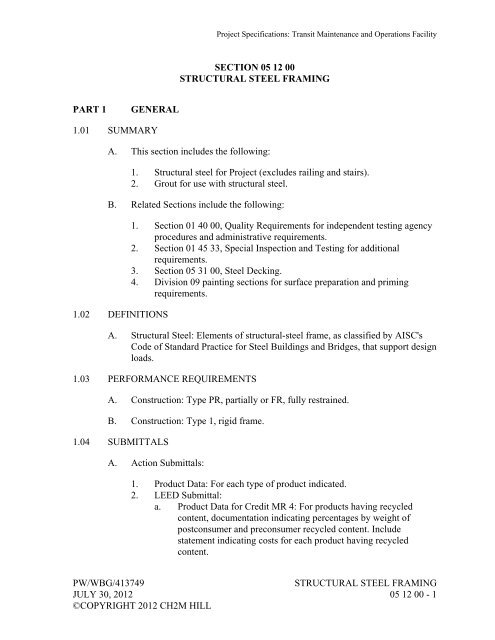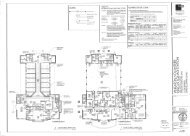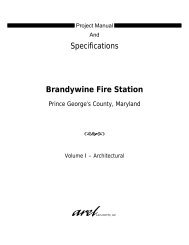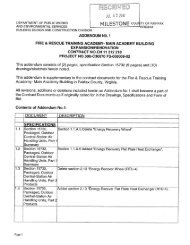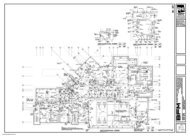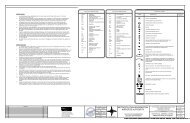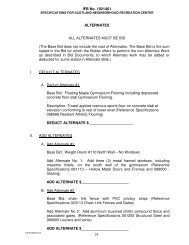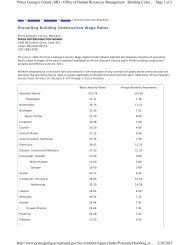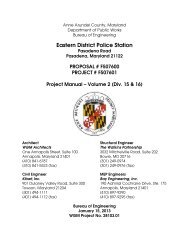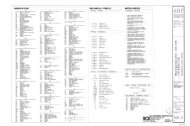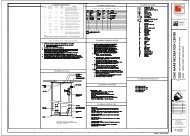05 12 00 Structural Steel Framing.pdf - Milestone Construction ...
05 12 00 Structural Steel Framing.pdf - Milestone Construction ...
05 12 00 Structural Steel Framing.pdf - Milestone Construction ...
You also want an ePaper? Increase the reach of your titles
YUMPU automatically turns print PDFs into web optimized ePapers that Google loves.
Project Specifications: Transit Maintenance and Operations Facility<br />
SECTION <strong>05</strong> <strong>12</strong> <strong>00</strong><br />
STRUCTURAL STEEL FRAMING<br />
PART 1<br />
GENERAL<br />
1.01 SUMMARY<br />
A. This section includes the following:<br />
1. <strong>Structural</strong> steel for Project (excludes railing and stairs).<br />
2. Grout for use with structural steel.<br />
B. Related Sections include the following:<br />
1.02 DEFINITIONS<br />
1. Section 01 40 <strong>00</strong>, Quality Requirements for independent testing agency<br />
procedures and administrative requirements.<br />
2. Section 01 45 33, Special Inspection and Testing for additional<br />
requirements.<br />
3. Section <strong>05</strong> 31 <strong>00</strong>, <strong>Steel</strong> Decking.<br />
4. Division 09 painting sections for surface preparation and priming<br />
requirements.<br />
A. <strong>Structural</strong> <strong>Steel</strong>: Elements of structural-steel frame, as classified by AISC's<br />
Code of Standard Practice for <strong>Steel</strong> Buildings and Bridges, that support design<br />
loads.<br />
1.03 PERFORMANCE REQUIREMENTS<br />
A. <strong>Construction</strong>: Type PR, partially or FR, fully restrained.<br />
B. <strong>Construction</strong>: Type 1, rigid frame.<br />
1.04 SUBMITTALS<br />
A. Action Submittals:<br />
1. Product Data: For each type of product indicated.<br />
2. LEED Submittal:<br />
a. Product Data for Credit MR 4: For products having recycled<br />
content, documentation indicating percentages by weight of<br />
postconsumer and preconsumer recycled content. Include<br />
statement indicating costs for each product having recycled<br />
content.<br />
PW/WBG/413749<br />
STRUCTURAL STEEL FRAMING<br />
JULY 30, 20<strong>12</strong> <strong>05</strong> <strong>12</strong> <strong>00</strong> - 1<br />
©COPYRIGHT 20<strong>12</strong> CH2M HILL
Project Specifications: Transit Maintenance and Operations Facility<br />
3. Shop Drawings: Show fabrication of structural-steel components.<br />
a. Include details of cuts, connections, splices, camber, holes, and<br />
other pertinent data.<br />
b. Include embedment drawings.<br />
c. Indicate welds by standard AWS symbols, distinguishing between<br />
shop and field welds, and show size, length, and type of each<br />
weld.<br />
d. Indicate type, size, and length of bolts, distinguishing between<br />
shop and field bolts. Identify pretensioned and slip-critical highstrength<br />
bolted connections.<br />
B. Informational Submittals:<br />
1. Welding certificates.<br />
2. Qualification Data: For Installer, fabricator and testing agency.<br />
3. Source quality-control test reports.<br />
4. Mill Certificates of tests made in accordance with ASTM A6.<br />
5. High-Strength Bolts (Plain Noncoated and Hot-Dip Galvanized):<br />
a. Certificates of Compliance that products meet chemical and<br />
mechanical requirements of standards specified.<br />
b. Manufacturer’s inspection test report results for production lot(s)<br />
furnished, to include:<br />
1) Tensile strength.<br />
2) Yield strength.<br />
3) Reduction of area.<br />
4) Elongation and hardness.<br />
c. Certified Mill Test Reports for Bolts and Nuts:<br />
1) Name and address of manufacturer.<br />
2) Bolts correctly marked.<br />
3) Marked bolts and nuts used in required mill tests and<br />
manufacturer’s inspection tests.<br />
1.<strong>05</strong> QUALITY ASSURANCE<br />
A. Installer Qualifications: A qualified installer who participates in the AISC<br />
Quality Certification Program and is designated an AISC-Certified Erector,<br />
Category CASE or CSE.<br />
B. Fabricator Qualifications: A qualified fabricator who participates in the AISC<br />
Quality Certification Program and is designated an AISC-Certified Plant,<br />
Category Cbd or Sbd.<br />
C. Shop-Painting Applicators: Qualified according to AISC's Sophisticated Paint<br />
Endorsement P1 or SSPC-QP 3, Standard Procedure for Evaluating<br />
Qualifications of Shop Painting Applicators.<br />
STRUCTURAL STEEL FRAMING<br />
PW/WBG/413749<br />
<strong>05</strong> <strong>12</strong> <strong>00</strong> - 2 JULY 30, 20<strong>12</strong><br />
©COPYRIGHT 20<strong>12</strong> CH2M HILL
Project Specifications: Transit Maintenance and Operations Facility<br />
D. Welding: Qualify procedures and personnel according to AWS D1.1,<br />
<strong>Structural</strong> Welding Code--<strong>Steel</strong>.<br />
E. Comply with applicable provisions of the following specifications and<br />
documents:<br />
1. AISC's Code of Standard Practice for <strong>Steel</strong> Buildings and Bridges.<br />
2. AISC's Seismic Provisions for <strong>Structural</strong> <strong>Steel</strong> Buildings and<br />
Supplement No. 2.<br />
3. AISC's Specification for <strong>Structural</strong> <strong>Steel</strong> Buildings--Allowable Stress<br />
Design and Plastic Design.<br />
4. AISC's Specification for the Design of <strong>Steel</strong> Hollow <strong>Structural</strong> Sections.<br />
5. AISC's Specification for Allowable Stress Design of Single-Angle<br />
Members.<br />
6. RCSC's Specification for <strong>Structural</strong> Joints Using ASTM A325 or A490<br />
Bolts.<br />
1.06 DELIVERY, STORAGE, AND HANDLING<br />
A. Store materials to permit easy access for inspection and identification. Keep<br />
steel members off ground and spaced by using pallets, dunnage, or other<br />
supports and spacers. Protect steel members and packaged materials from<br />
erosion and deterioration.<br />
1.07 COORDINATION<br />
1. Store fasteners in a protected place. Clean and relubricate bolts and nuts<br />
that become dry or rusty before use.<br />
2. Do not store materials on structure in a manner that might cause<br />
distortion, damage, or overload to members or supporting structures.<br />
Repair or replace damaged materials or structures as directed.<br />
A. Furnish anchorage items to be embedded in or attached to other construction<br />
without delaying the Work. Provide setting diagrams, sheet metal templates,<br />
instructions, and directions for installation.<br />
PART 2<br />
PRODUCTS<br />
2.01 STRUCTURAL-STEEL MATERIALS<br />
A. Recycled Content of <strong>Steel</strong> Products: Provide products with an average<br />
recycled content of steel products so postconsumer recycled content plus onehalf<br />
of preconsumer recycled content is not less than 60 percent.<br />
PW/WBG/413749<br />
STRUCTURAL STEEL FRAMING<br />
JULY 30, 20<strong>12</strong> <strong>05</strong> <strong>12</strong> <strong>00</strong> - 3<br />
©COPYRIGHT 20<strong>12</strong> CH2M HILL
Project Specifications: Transit Maintenance and Operations Facility<br />
B. Recycled Content of <strong>Steel</strong> Products: Provide products with an average<br />
recycled content of steel products so postconsumer recycled content plus onehalf<br />
of preconsumer recycled content is not less than the following:<br />
1. W-Shapes: 60 percent.<br />
2. Channels, Angles-Shapes: 60 percent.<br />
3. Plate and Bar: 25 percent.<br />
4. WT-Shapes: 60 percent.<br />
5. All Other <strong>Steel</strong> Materials: 25 percent.<br />
C. W-Shapes: ASTM A992/A992M, Grade 50.<br />
D. Channels, Angles-Shapes: ASTM A992/A992M, Grade 50.<br />
E. Plate and Bar: ASTM A36/A36M.<br />
F. Welding Electrodes: Comply with AWS requirements.<br />
2.02 BOLTS, CONNECTORS, AND ANCHORS<br />
A. High-Strength Bolts, Nuts, and Washers: ASTM A325 (ASTM A325M),<br />
Type 1, heavy hex steel structural bolts; ASTM A563 (ASTM A563M) heavy<br />
hex carbon-steel nuts; and ASTM F436 (ASTM F436M) hardened carbonsteel<br />
washers.<br />
1. Finish: Hot-dip zinc coating, ASTM A153/A153M, Class C.<br />
2. Direct-Tension Indicators: ASTM F959, Type 325 (ASTM F959M,<br />
Type 8.8,) compressible-washer type.<br />
a. Finish: Mechanically deposited zinc coating, ASTM B695, Class 50.<br />
B. Shear Connectors: ASTM A108, Grades 1015 through 1020, headed-stud<br />
type, cold-finished carbon steel; AWS D1.1, Type B.<br />
C. Threaded Rods: ASTM A36/A36M.<br />
2.03 PRIMER<br />
1. Nuts: ASTM A563 (ASTM A563M) heavy hex carbon steel.<br />
2. Washers: ASTM A36/A36M carbon steel.<br />
3. Finish: Hot-dip zinc coating, ASTM A153/A153M, Class C.<br />
A. Primer: SSPC-Paint 25, Type I, iron oxide, zinc oxide, raw linseed oil, and<br />
alkyd.<br />
B. Primer: Fabricator's standard lead- and chromate-free, nonasphaltic, rustinhibiting<br />
primer coordinated with Division 09 products.<br />
STRUCTURAL STEEL FRAMING<br />
PW/WBG/413749<br />
<strong>05</strong> <strong>12</strong> <strong>00</strong> - 4 JULY 30, 20<strong>12</strong><br />
©COPYRIGHT 20<strong>12</strong> CH2M HILL
Project Specifications: Transit Maintenance and Operations Facility<br />
2.04 GROUT<br />
C. Unless noted otherwise all members shall be shop primed and prepared to<br />
receive field paint.<br />
A. Metallic, Shrinkage-Resistant Grout: ASTM C1107, factory-packaged,<br />
metallic aggregate grout, mixed with water to consistency suitable for<br />
application and a 30-minute working time.<br />
2.<strong>05</strong> FABRICATION<br />
A. <strong>Structural</strong> <strong>Steel</strong>: Fabricate and assemble in shop to greatest extent possible.<br />
Fabricate according to AISC's Code of Standard Practice for <strong>Steel</strong> Buildings<br />
and Bridges and AISC's Specification for <strong>Structural</strong> <strong>Steel</strong> Buildings-<br />
Allowable Stress Design and Plastic Design.<br />
1. Camber structural-steel members where indicated.<br />
2. Identify high-strength structural steel according to ASTM A6/A6M and<br />
maintain markings until structural steel has been erected.<br />
3. Mark and match-mark materials for field assembly.<br />
4. Complete structural-steel assemblies, including welding of units, before<br />
starting shop-priming operations.<br />
B. Thermal Cutting: Perform thermal cutting by machine to greatest extent<br />
possible.<br />
1. Plane thermally cut edges to be welded to comply with requirements in<br />
AWS D1.1.<br />
C. Bolt Holes: Cut, drill, mechanically thermal cut, or punch standard bolt holes<br />
perpendicular to metal surfaces.<br />
D. Finishing: Accurately finish ends of columns and other members transmitting<br />
bearing loads.<br />
E. Shear Connectors: Prepare steel surfaces as recommended by manufacturer of<br />
shear connectors. Use automatic end welding of headed-stud shear connectors<br />
according to AWS D1.1 and manufacturer's written instructions.<br />
F. <strong>Steel</strong> Wall-Opening <strong>Framing</strong>: Select true and straight members for fabricating<br />
steel wall-opening framing to be attached to structural steel. Straighten as<br />
required to provide uniform, square, and true members in completed wall<br />
framing.<br />
PW/WBG/413749<br />
STRUCTURAL STEEL FRAMING<br />
JULY 30, 20<strong>12</strong> <strong>05</strong> <strong>12</strong> <strong>00</strong> - 5<br />
©COPYRIGHT 20<strong>12</strong> CH2M HILL
Project Specifications: Transit Maintenance and Operations Facility<br />
G. Holes: Provide holes required for securing other work to structural steel and<br />
for passage of other work through steel framing members.<br />
1. Cut, drill, or punch holes perpendicular to steel surfaces. Do not<br />
thermally cut bolt holes or enlarge holes by burning.<br />
2. Base-Plate Holes: Cut, drill, mechanically thermal cut, or punch holes<br />
perpendicular to steel surfaces.<br />
3. Weld threaded nuts to framing and other specialty items indicated to<br />
receive other work.<br />
2.06 SHOP CONNECTIONS<br />
A. High-Strength Bolts: Shop install high-strength bolts according to RCSC's<br />
Specification for <strong>Structural</strong> Joints Using ASTM A325 or A490 Bolts for type<br />
of bolt and type of joint specified.<br />
1. Joint Type: Snug tightened.<br />
B. Weld Connections: Comply with AWS D1.1 for welding procedure<br />
specifications, tolerances, appearance, and quality of welds and for methods<br />
used in correcting welding work.<br />
2.07 SHOP PRIMING<br />
1. Assemble and weld built-up sections by methods that will maintain true<br />
alignment of axes without exceeding tolerances of AISC's Code of<br />
Standard Practice for <strong>Steel</strong> Buildings and Bridges for mill material.<br />
2. Follow Section <strong>05</strong> <strong>05</strong> 23, Welding.<br />
A. Shop prime steel surfaces except the following:<br />
1. Surfaces embedded in concrete or mortar. Extend priming of partially<br />
embedded members to a depth of 2 inches.<br />
2. Surfaces to be field welded.<br />
3. Surfaces to be high-strength bolted with slip-critical connections.<br />
4. Surfaces to receive sprayed fire-resistive materials.<br />
B. Surface Preparation: Clean surfaces to be painted. Remove loose rust and mill<br />
scale and spatter, slag, or flux deposits. Prepare surfaces according to the<br />
following specifications and standards:<br />
1. SSPC-SP 2, Hand Tool Cleaning.<br />
2. SSPC-SP 3, Power Tool Cleaning.<br />
C. Priming: Immediately after surface preparation, apply primer according to<br />
manufacturer's written instructions and at rate recommended by SSPC to provide<br />
STRUCTURAL STEEL FRAMING<br />
PW/WBG/413749<br />
<strong>05</strong> <strong>12</strong> <strong>00</strong> - 6 JULY 30, 20<strong>12</strong><br />
©COPYRIGHT 20<strong>12</strong> CH2M HILL
Project Specifications: Transit Maintenance and Operations Facility<br />
a dry film thickness of not less than 1.5 mils. Use priming methods that result in<br />
full coverage of joints, corners, edges, and exposed surfaces.<br />
1. Stripe paint corners, crevices, bolts, welds, and sharp edges.<br />
2. Apply two coats of shop paint to inaccessible surfaces after assembly or<br />
erection. Change color of second coat to distinguish it from first.<br />
D. Painting: Apply a 1-coat, nonasphaltic primer complying with<br />
SSPC-PS Guide 7.<strong>00</strong>, Painting System Guide 7.<strong>00</strong>: Guide for Selecting One-<br />
Coat Shop Painting Systems, to provide a dry film thickness of not less than<br />
1.5 mils. Ensure compatible with Division 09 Specification sections for final<br />
finish to be applied.<br />
2.08 SOURCE QUALITY CONTROL<br />
A. Contractor shall engage an independent testing and inspecting agency to<br />
perform shop tests and inspections and prepare test reports.<br />
1. Provide testing agency with access to places where structural-steel work<br />
is being fabricated or produced to perform tests and inspections.<br />
B. Correct deficiencies in Work that test reports and inspections indicate does<br />
not comply with the Contract Documents.<br />
C. Bolted Connections: Shop-bolted connections will be tested and inspected<br />
according to RCSC's Specification for <strong>Structural</strong> Joints Using ASTM A325 or<br />
A490 Bolts.<br />
D. Welded Connections (see also Section <strong>05</strong> <strong>05</strong> 23, Welding): In addition to visual<br />
inspection, shop-welded connections will be tested and inspected according to<br />
AWS D1.1 and the following inspection procedures, at testing agency's option:<br />
1. Liquid Penetrant Inspection: ASTM E165.<br />
2. Magnetic Particle Inspection: ASTM E709; performed on root pass and<br />
on finished weld. Cracks or zones of incomplete fusion or penetration<br />
will not be accepted.<br />
3. Ultrasonic Inspection: ASTM E164.<br />
4. Radiographic Inspection: ASTM E94.<br />
E. In addition to visual inspection, shop-welded shear connectors will be tested<br />
and inspected according to requirements in AWS D1.1 for stud welding and as<br />
follows:<br />
1. Bend tests will be performed if visual inspections reveal either a lessthan-<br />
continuous 360-degree flash or welding repairs to any shear<br />
connector.<br />
PW/WBG/413749<br />
STRUCTURAL STEEL FRAMING<br />
JULY 30, 20<strong>12</strong> <strong>05</strong> <strong>12</strong> <strong>00</strong> - 7<br />
©COPYRIGHT 20<strong>12</strong> CH2M HILL
Project Specifications: Transit Maintenance and Operations Facility<br />
2. Tests will be conducted on additional shear connectors if weld fracture<br />
occurs on shear connectors already tested, according to requirements in<br />
AWS D1.1.<br />
PART 3<br />
EXECUTION<br />
3.01 EXAMINATION<br />
A. Verify elevations of concrete- and masonry-bearing surfaces and locations of<br />
anchor rods, bearing plates, and other embedment’s, with steel erector present,<br />
for compliance with requirements.<br />
B. Proceed with installation only after unsatisfactory conditions have been<br />
corrected.<br />
3.02 PREPARATION<br />
A. Provide temporary shores, guys, braces, and other supports during erection to<br />
keep structural steel secure, plumb, and in alignment against temporary<br />
construction loads and loads equal in intensity to design loads. Remove<br />
temporary supports when permanent structural steel, connections, and bracing<br />
are in place, unless otherwise indicated.<br />
3.03 ERECTION<br />
1. Do not remove temporary shoring supporting composite deck<br />
construction until cast-in-place concrete has attained its design<br />
compressive strength.<br />
A. Set structural steel accurately in locations and to elevations indicated and<br />
according to AISC's Code of Standard Practice for <strong>Steel</strong> Buildings and<br />
Bridges and Specification for <strong>Structural</strong> <strong>Steel</strong> Buildings--Allowable Stress<br />
Design and Plastic Design.<br />
B. Base and Bearing Plates: Clean concrete- and masonry-bearing surfaces of<br />
bond-reducing materials, and roughen surfaces prior to setting base and<br />
bearing plates. Clean bottom surface of base and bearing plates.<br />
1. Set base and bearing plates for structural members on wedges, shims, or<br />
setting nuts as required.<br />
2. Weld plate washers to top of base plate.<br />
3. Snug-tighten anchor rods after supported members have been positioned<br />
and plumbed. Do not remove wedges or shims but, if protruding, cut off<br />
flush with edge of base or bearing plate before packing with grout.<br />
4. Promptly pack grout solidly between bearing surfaces and base or<br />
bearing plates so no voids remain. Neatly finish exposed surfaces;<br />
STRUCTURAL STEEL FRAMING<br />
PW/WBG/413749<br />
<strong>05</strong> <strong>12</strong> <strong>00</strong> - 8 JULY 30, 20<strong>12</strong><br />
©COPYRIGHT 20<strong>12</strong> CH2M HILL
Project Specifications: Transit Maintenance and Operations Facility<br />
protect grout and allow to cure. Comply with manufacturer's written<br />
installation instructions for shrinkage-resistant grouts.<br />
C. Maintain erection tolerances of structural steel within AISC's Code of<br />
Standard Practice for <strong>Steel</strong> Buildings and Bridges.<br />
D. Align and adjust various members forming part of complete frame or structure<br />
before permanently fastening. Before assembly, clean bearing surfaces and<br />
other surfaces that will be in permanent contact with members. Perform<br />
necessary adjustments to compensate for discrepancies in elevations and<br />
alignment.<br />
1. Level and plumb individual members of structure.<br />
2. Make allowances for difference between temperature at time of erection<br />
and mean temperature when structure is completed and in service.<br />
E. Splice members only where indicated.<br />
F. Do not use thermal cutting during erection unless approved by Contracting<br />
Officer. Finish thermally cut sections within smoothness limits in AWS D1.1.<br />
G. Do not enlarge unfair holes in members by burning or using drift pins. Ream<br />
holes that must be enlarged to admit bolts.<br />
H. Shear Connectors: Prepare steel surfaces as recommended by manufacturer of<br />
shear connectors. Use automatic end welding of headed-stud shear connectors<br />
according to AWS D1.1 and manufacturer's written instructions.<br />
3.04 FIELD CONNECTIONS<br />
A. High-Strength Bolts: Install high-strength bolts according to RCSC's<br />
Specification for <strong>Structural</strong> Joints Using ASTM A325 or A490 Bolts for type<br />
of bolt and type of joint specified.<br />
1. Joint Type: Snug tightened.<br />
B. Weld Connections: Comply with AWS D1.1 for welding procedure<br />
specifications, tolerances, appearance, and quality of welds and for methods<br />
used in correcting welding work.<br />
1. Comply with AISC's Code of Standard Practice for <strong>Steel</strong> Buildings and<br />
Bridges and Specification for <strong>Structural</strong> <strong>Steel</strong> Buildings--Allowable<br />
Stress Design and Plastic Design for bearing, adequacy of temporary<br />
connections, alignment, and removal of paint on surfaces adjacent to<br />
field welds.<br />
PW/WBG/413749<br />
STRUCTURAL STEEL FRAMING<br />
JULY 30, 20<strong>12</strong> <strong>05</strong> <strong>12</strong> <strong>00</strong> - 9<br />
©COPYRIGHT 20<strong>12</strong> CH2M HILL
Project Specifications: Transit Maintenance and Operations Facility<br />
2. Assemble and weld built-up sections by methods that will maintain true<br />
alignment of axes without exceeding tolerances of AISC's Code of<br />
Standard Practice for <strong>Steel</strong> Buildings and Bridges for mill material.<br />
3.<strong>05</strong> FIELD QUALITY CONTROL<br />
A. Testing and Inspecting: Owner will engage a qualified testing and inspecting<br />
agency to perform tests and inspections and to submit reports.<br />
B. Testing Agency: Owner will engage a qualified independent testing and<br />
inspecting agency to inspect field welds and high-strength bolted connections.<br />
C. Bolted Connections: Shop-bolted connections will be tested and inspected<br />
according to RCSC's Specification for <strong>Structural</strong> Joints Using ASTM A325 or<br />
A490 Bolts.<br />
D. Welded Connections: Field welds will be visually inspected according to<br />
AWS D1.1.<br />
1. In addition to visual inspection, field welds will be tested according to<br />
AWS D1.1 and the following inspection procedures, at testing agency's<br />
option:<br />
a. Liquid Penetrant Inspection: ASTM E165.<br />
b. Magnetic Particle Inspection: ASTM E709; performed on root<br />
pass and on finished weld. Cracks or zones of incomplete fusion<br />
or penetration will not be accepted.<br />
c. Ultrasonic Inspection: ASTM E164.<br />
d. Radiographic Inspection: ASTM E94.<br />
E. In addition to visual inspection, test and inspect field-welded shear connectors<br />
according to requirements in AWS D1.1 for stud welding and as follows:<br />
1. Perform bend tests if visual inspections reveal either a less-thancontinuous<br />
360-degree flash or welding repairs to any shear connector.<br />
2. Conduct tests on additional shear connectors if weld fracture occurs on<br />
shear connectors already tested, according to requirements in<br />
AWS D1.1.<br />
F. Correct deficiencies in Work that test reports and inspections indicate does<br />
not comply with the Contract Documents.<br />
STRUCTURAL STEEL FRAMING<br />
PW/WBG/413749<br />
<strong>05</strong> <strong>12</strong> <strong>00</strong> - 10 JULY 30, 20<strong>12</strong><br />
©COPYRIGHT 20<strong>12</strong> CH2M HILL
Project Specifications: Transit Maintenance and Operations Facility<br />
3.06 REPAIRS AND PROTECTION<br />
A. Touchup Painting: After installation, promptly clean, prepare, and prime or<br />
reprime field connections, rust spots, and abraded surfaces of prime-painted<br />
joists and accessories, bearing plates, and abutting structural steel.<br />
1. Clean and prepare surfaces by SSPC-SP 2 hand-tool cleaning or<br />
SSPC-SP 3 power-tool cleaning.<br />
2. Apply a compatible primer of same type as shop primer used on<br />
adjacent surfaces.<br />
B. Touchup Painting: Cleaning and touchup painting are specified in Division 09<br />
painting sections.<br />
END OF SECTION<br />
PW/WBG/413749<br />
STRUCTURAL STEEL FRAMING<br />
JULY 30, 20<strong>12</strong> <strong>05</strong> <strong>12</strong> <strong>00</strong> - 11<br />
©COPYRIGHT 20<strong>12</strong> CH2M HILL


